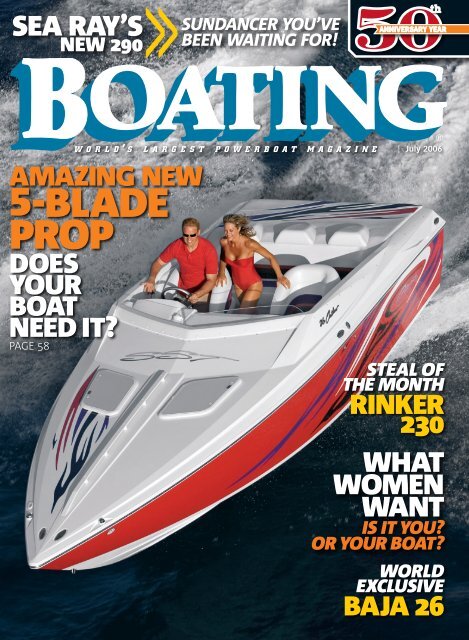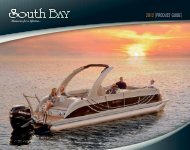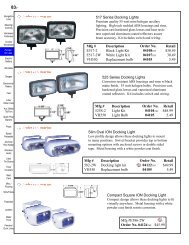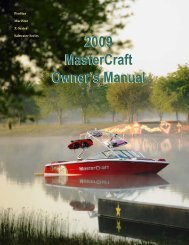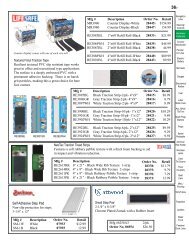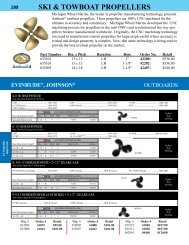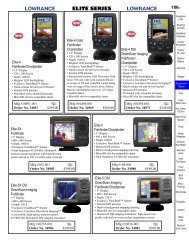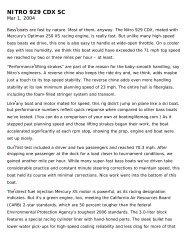Create successful ePaper yourself
Turn your PDF publications into a flip-book with our unique Google optimized e-Paper software.
sea ray’s<br />
NeW 290>><br />
w o r l d ’ s l a r g e s t p o w e r b o a t m a g a z i n e<br />
aMaZING NeW<br />
5-<strong>BLaDe</strong><br />
<strong>PrOP</strong><br />
DOes<br />
yOur<br />
BOat<br />
NeeD It?<br />
page 58<br />
SUNDANCER YOU’VE<br />
BEEN WAITING FOR!<br />
ANNIVERSARY YEAR<br />
50th<br />
®<br />
| July 2006<br />
sTeAl of<br />
The monTh<br />
rINker<br />
230<br />
WHat<br />
WOMeN<br />
WaNt<br />
is iT You?<br />
or Your BoAT?<br />
world<br />
exclusive<br />
BaJa 26
BoatTest2419<br />
Baja 26 Outlaw<br />
CaNDy GIrL<br />
Hot out of the box. By eric colBy<br />
Consider two boats built by the same manufacturer.<br />
One is a foot longer than the other. They<br />
weigh the same and have identical beams, but<br />
the bigger boat is faster. The first thing most gofast<br />
enthusiasts would think is “stepped bottom.” In the<br />
case of the new Baja 26 Outlaw, that assumption would<br />
be as wrong as a size 14 thong.<br />
When Baja retired its 25 Outlaw and introduced the<br />
26 Outlaw, the builder stuck with the old-school, tried-<br />
wIth ItS hotrod StyLING ANd StroNG PErformANCE, thE<br />
outLAw wILL StEAL your hEArt. toP ENd: 66.3 mPh.<br />
and-true, deep-V design. Here’s the wrinkle, though: The<br />
25 Outlaw had 1 1 ⁄2 strakes per side; the newer, bigger<br />
boat has 2 1 ⁄2 strakes.<br />
They’re called lifting strakes for a reason—they provide<br />
lift. And as you know, lift reduces friction between<br />
the wetted surface and the water. The 26 Outlaw runs a<br />
competitive 66.3-mph top speed (about 1 mph faster than<br />
its predecessor ran on the same power) while keeping the<br />
boating magazine J U LY 2 0 0 6<br />
As seen in<br />
Celebrating 50 years as<br />
The World's Largest<br />
Powerboat Magazine<br />
more predictable handling that comes with a nonstepped<br />
bottom design. Combine the extra strakes with all the<br />
drag-reducing tests that Baja conducts on its boats and<br />
the University of Michigan’s wind-tunnel tests and you<br />
get the most efficient straight V-bottom around.<br />
The boat planed in 5.4 seconds and held plane at 17<br />
mph, proving it can handle the task of towing toys and<br />
boarders. In midrange acceleration tests, the 26 Outlaw<br />
ran from 30 to 40 mph in 4.6 seconds and from 40 to 50<br />
mph in 3.9 seconds. Our test boat had the optional labfinished<br />
prop ($920), but Baja says it only nets about<br />
1 mph difference.<br />
I cranked the boat through turns at 50 and 60 mph<br />
and whipped it into slaloms at 50. It responded predictably,<br />
thanks in part to chines that are turned down five<br />
degrees.<br />
How competitive is the 26 Outlaw’s top speed?<br />
Fountain’s 27 Fever ($79,593 with the 496 MAG HO<br />
Bravo One X) runs an estimated 68 mph on a single-step<br />
design, but remember, it has a molded swim platform<br />
and a 2' bow extension, resulting in a 24' running surface.<br />
The Baja has a flat transom, making it a true 26' boat.<br />
The Advantage 27 Victory ($88,400 with the same<br />
power) has two small steps and runs 65 mph.<br />
LIVING SPACE Besides being superior to the 25 Outlaw<br />
on the water, the 26 Outlaw has a better cockpit, too. On<br />
the old boat, the gap between the bench seat and the bolsters<br />
was so tight you couldn’t stand up straight—bent<br />
knees were required. Honestly, it was more comfortable<br />
to sit back down. Baja put an additional 4" of space<br />
between the bench and bolsters on the 26 Outlaw, so you<br />
can now stand up or stretch out your legs and brace<br />
against the lower bars of the front seat’s stainless-steel<br />
frames. The bolsters also have handholds built into the<br />
backs for security. I liked the wraparound lumbar support<br />
on the bench seat but would have preferred a wider opening<br />
on the inwale grabrails. I could barely get my fingers<br />
in there.<br />
The 26 Outlaw’s cockpit is also a few inches wider, giving<br />
the boat a much bigger feel overall and allowing for a<br />
cavernous locker in the bench-seat base. Borrowing a<br />
w w w. b o at i n g m a g. c o m<br />
PHOtOs FOReST JOHNSON
BOATING<br />
Certified Test Results<br />
Baja 26 outlaw<br />
thE hIGhS Conventional V-bottom design that’s nearly as fast<br />
as a stepped bottom and handles better. Larger cockpit is always<br />
a bonus. Love the stout motor mounts. A cabin that can sleep a<br />
family of four.<br />
thE LowS Stern cleats should be on transom, not on hullsides.<br />
Grabrails for the bench seat passengers are too tight to get<br />
a hand around. Glovebox is too small.<br />
SPEEd EffICIENCy oPErAtIoN<br />
naut. stat. n. mi. s. mi. run sound<br />
rpm knots mph gph mpg mpg range range angle level<br />
1000 5.1 5.9 2.8 1.8 2.1 166 192 0 72<br />
1500 7.0 8.0 4.6 1.5 1.7 137 158 3 78<br />
2000 9.5 10.9 6.6 1.4 1.7 130 150 5 86<br />
2500 22.4 25.8 8.2 2.7 3.1 249 286 1 87<br />
3000 28.7 33.0 10.6 2.7 3.1 246 283 2 88<br />
3500 35.8 41.2 15.5 2.3 2.7 210 242 2 92<br />
4000 41.8 48.1 18.9 2.2 2.5 201 231 2 95<br />
4500 49.1 56.5 27.5 1.8 2.1 162 187 1 98<br />
5000 57.6 66.3 34.6 1.7 1.9 151 174 0 99<br />
Advertised fuel capacity 101 gallons. Range based on 90 percent of that<br />
figure. Performance measured with two persons aboard, half fuel. Sound<br />
levels taken at helm, in dB-A.<br />
$<br />
Monthly Payment $650<br />
(7.12% interest with 10% down on test boat power, tax not included;<br />
15-year loan to qualified buyers estimated by Excel Credit)<br />
LOA 26'<br />
Beam 8'2"<br />
Draft (max.) 3'2"<br />
Displacement 4,800<br />
Transom deadrise 24°<br />
Bridge clearance 4'4"<br />
Max. cabin headroom 4'6"<br />
Fuel capacity (gal.) 101<br />
Price (w/standard power) $72,300<br />
Price (w/test power) $79,700<br />
standard power Single 375-hp<br />
MerCruiser 496 MAG Bravo One X<br />
V-8 gasoline stern drive.<br />
ContaCt Baja Marine Corp., Dept. B, Box 151, Bucyrus, OH 44820,<br />
419/562-5377, www.bajamarine.com.<br />
with a clean finish and have cargo nets to help contain<br />
towels and dock lines. Speaking of dock lines, it<br />
would be easier to cross-tie the boat in a slip if the stern<br />
cleats were installed along the transom instead of on<br />
the sides of the deck because the lines wouldn’t have to<br />
wrap around a corner, which could abrade the rope or<br />
mar the gel coat.<br />
Up front, there’s a small draining glovebox in the<br />
boating magazine J U LY 2 0 0 6<br />
optional power Single gasoline<br />
stern drive to 600 hp.<br />
test Boat power Single 425-hp<br />
MerCruiser 496 MAG HO Bravo One<br />
X V-8 gasoline stern drive with 496<br />
cid, swinging a 14 5 ⁄8" x 23" Mirage<br />
three-bladed ss prop through a 1.5:1<br />
reduction.<br />
standard equipment (major<br />
items) Six 6" pull-up ss cleats; acrylic<br />
windscreen; backlit Livorsi Marine<br />
instrumentation, Livorsi Marine<br />
engine controls w/trim on throttle;<br />
tilt wheel; 12v power plug; AM/FM/<br />
CD stereo; 500- and 900-ghp bilge<br />
pumps; CO detector; single battery<br />
in Gil Marine tray; battery switch.<br />
port dash that locks and contains a 12-volt power plug.<br />
To starboard, the helm has Livorsi Marine Platinum<br />
Series gauges set in a carbon-fiber panel, which kills<br />
glare. The trim gauge is on the starboard side of the<br />
panel just ahead of the controls, right where you want it.<br />
Steps molded into the console make it easy to get out<br />
onto the foredeck.<br />
PowEr PLAy Finally, the 26 Outlaw’s engine compartment<br />
is longer than its predecessor’s, leaving more space<br />
ahead of the motor for maintenance or for serious speed<br />
addicts who want to upgrade to the Mercury Racing<br />
HP600SCi supercharged motor (price wasn’t available<br />
at press time for this option). The compartment is also<br />
deep enough to accommodate the taller blown engine<br />
without the need for modifying the hatch.<br />
My test boat’s hatch opened on a hydraulic ram,<br />
revealing the aft end of the single molded liner that<br />
includes the stringers, transverse supports, and both the<br />
cockpit and cabin soles. The stringers in the engine<br />
compartment are cored with fiberglass-encapsulated<br />
marine plywood and reinforced with carbon fiber and<br />
Kevlar for maximum strength and minimum weight.<br />
The bottom, hullsides, and deck are cored with endgrain<br />
balsa and the hull-to-deck joint is bonded with<br />
Plexus adhesive.<br />
You want strength? Check out the motor mounts.<br />
Instead of using L-angle mounts with backing plates,<br />
Baja welds together the L-bracket and 1 ⁄2" aluminum<br />
backing plate, creating a full cap over the bearer, and<br />
then uses 1 ⁄2"-diameter through-bolts to secure the<br />
whole piece to the stringer. Finally, the vertical tab that<br />
the motor mount bolts through is also welded to the<br />
bracket, distributing the load over the 2' length of the<br />
bracket on each side. The battery is secured in a Gil<br />
Marine box to starboard as is the drive trim pump. To<br />
port is the anchor tray into which a Danforth-style<br />
model clips and hangs while you’re running. The wires<br />
and hoses are supported in stainless-steel cushioned<br />
clamps and the routing is easy to follow.<br />
The final spot where the bigger boat outshines the<br />
smaller one is in the cabin where there’s sleeping space<br />
for a family of four on the long V-berth and on the aft<br />
lounges that convert to a second berth with three aluminum<br />
stanchions that support the backrests for the<br />
couches when they’re slipped into place. There’s stowage<br />
under the bottom cushions for the lounges and forward<br />
under the V-berth if you don’t opt for the portable head<br />
!<br />
EXTRA POINT<br />
It’s a good thing the boat works so well because<br />
its bottom will also be used on three future models:<br />
the 272 Islander, a 27' closed-bow model, and a 27'<br />
midcabin bowrider.<br />
w w w. b o at i n g m a g. c o m


